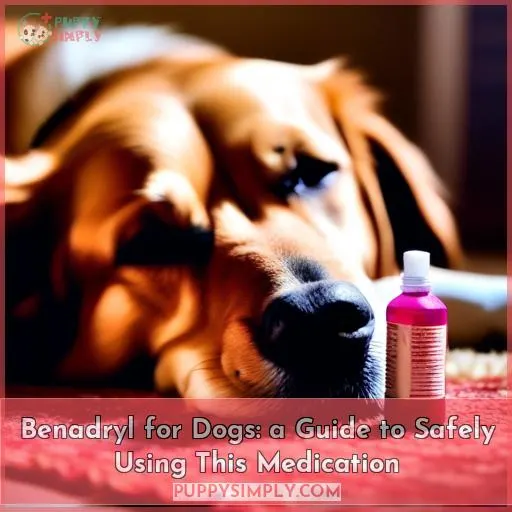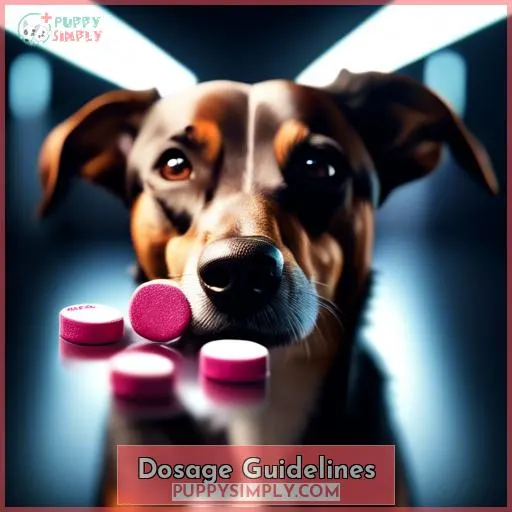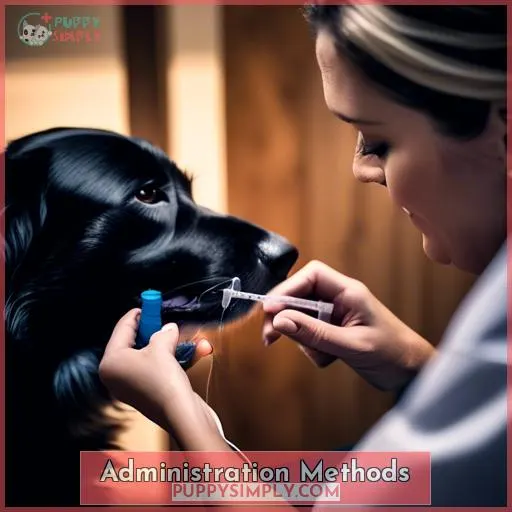This site is supported by our readers. We may earn a commission, at no cost to you, if you purchase through links.
 Ah, the age-old question: Can you give your furry friend a dose of Benadryl?
Ah, the age-old question: Can you give your furry friend a dose of Benadryl?
Indeed, navigating the world of medications for our canine companions can feel like decoding a cryptic puzzle. But fear not! With a sprinkle of humor and a dash of expertise, let’s dive into the safe use of Benadryl for dogs.
Whether it’s battling those pesky seasonal allergies or calming the nerves during a thunderstorm, this guide will arm you with the knowledge to safely administer this medication.
Table Of Contents
- Key Takeaways
- Understanding Benadryl for Dogs
- Dosage Guidelines
- Administration Methods
- Safety and Precautions
- Recognizing Side Effects
- Benadryl for Allergies
- Benadryl for Anxiety and Motion Sickness
- Special Considerations
- Alternatives to Benadryl
- Emergency Situations
- Frequently Asked Questions (FAQs)
- How long does it take for Benadryl to wear off in dogs?
- Can Benadryl be used to treat other conditions in dogs apart from allergies and anxiety?
- How does Benadryl interact with other medications my dog might be taking?
- Can Benadryl be used in dogs for long-term treatment of chronic conditions?
- What should I do if my dog accidentally ingests more Benadryl than the recommended dose?
- Conclusion
Key Takeaways
Here are 4 key takeaways about Benadryl for dogs based on the background provided:
- Calculate the dose based on your dog’s weight, typically 1-2 mg of Benadryl per pound body weight, administered 2-3 times daily.
- Monitor your dog closely when giving Benadryl, especially if they have other health conditions or are on other medications.
- Recognize potential side effects like sedation and contact your vet if you suspect an overdose.
- Explore alternative antihistamines or natural remedies if your dog has adverse reactions to Benadryl.
Understanding Benadryl for Dogs
When considering Benadryl for your dog, it’s crucial to understand its uses and how it works.
Benadryl, a first-generation antihistamine, is commonly used to alleviate symptoms of allergies and motion sickness in dogs.
It’s essential to consult with your veterinarian to ensure it’s appropriate for your pet’s specific health needs and to determine the correct dosage.
Overview and Uses
While Benadryl® isn’t FDA-approved for veterinary use, it’s commonly prescribed by veterinarians to help you manage your dog’s mild-to-moderate allergies, including symptoms like itching, sneezing, and hives.
This antihistamine can also be used to treat motion sickness and mild anxiety in dogs.
However, it’s crucial to consult with your vet to determine the safe dosage and to understand potential side effects.
Always consider alternative treatments if Benadryl® isn’t suitable for your dog’s specific health conditions.
How It Works
Benadryl’s antihistamine action in dogs involves blocking the H1 histamine receptors, which helps prevent the allergic symptoms you’re familiar with.
This histamine blockade offers allergy relief and, due to its sedation mechanism, can aid in anxiety treatment.
However, be mindful of dosage to avoid diphenhydramine toxicity.
Pathologic analysis and analytical evidence are crucial in forensic implications, especially in criminal investigations involving motive evaluation.
Dosage Guidelines
When considering Benadryl for your dog, it’s crucial to calculate the correct dose and understand the frequency of administration.
You’ll need to consider your dog’s weight, as the general dosage guideline is 1-2 milligrams per pound of body weight, which can be given up to three times a day.
Always consult with your veterinarian before starting any new medication to ensure it’s safe for your dog’s specific health needs and to confirm the appropriate dosage.
Calculating the Correct Dose
After understanding the basics of Benadryl and its uses for dogs, it’s time to delve into how to calculate the correct dose for your pet.
The key is weight-based dosage; typically, 1-2 mg of diphenhydramine per pound of your dog’s weight ensures safe administration.
This careful calculation prevents overdose, crucial for managing pet allergies and ensuring an effective emergency response.
Frequency of Administration
Once you’ve determined the correct dose of Benadryl for your dog, it’s important to understand how often this medication should be administered.
Generally, Benadryl can be given to dogs 2-3 times per day, roughly every 8-12 hours.
However, timing considerations and frequency variations may depend on your dog’s specific needs and reactions.
Always monitor your pet for signs of allergic reactions, anxiety, or potential poisoning.
Administration Methods
When it comes to administering Benadryl to your dog, it’s crucial to choose the right form and dosage to ensure safety and effectiveness.
Tablets, capsules, and liquid forms are available, each suited to different sizes and preferences of dogs.
Accurate dosing is key, with general guidelines suggesting 1-2 mg per pound of body weight, tailored to your dog’s specific needs and health condition.
Tablets and Capsules
When transitioning from dosage guidelines to administration methods, it’s important to be aware that Benadryl tablets and capsules should be given orally to your dog as prescribed by your veterinarian.
If your furry friend is on the smaller side or you’re managing long-term usage, consider tablet alternatives like the liquid formulation, which can be easier to dose accurately for petite pooches.
Always keep emergency protocols in mind, especially if your dog has a history of adverse reactions to medications.
Liquid Form Dosage
While considering the administration of liquid Benadryl to your dog, it’s essential to calculate the correct dosage to ensure safety and effectiveness.
The general rule of thumb is to administer 0.9 to 1.8 milligrams per pound of your dog’s body weight, typically 1-2 times per day.
However, dosing challenges can arise due to canine absorption rates and the pet’s size.
Always consult your vet for precise dosing instructions to avoid toxicity and ensure the medication effectively alleviates your dog’s allergy symptoms.
Safety and Precautions
When considering Benadryl for your dog, it’s crucial to be aware of their health status and any medications they’re currently taking.
You’ll need to exercise caution if your dog has conditions like glaucoma, heart disease, or is pregnant, as Benadryl could pose risks.
Always consult your veterinarian before administering Benadryl, especially if your dog is on other medications, to avoid potential adverse interactions.
Health Conditions to Monitor
Monitoring your dog’s health conditions is crucial when administering Benadryl, as it’s not suitable for all pets.
Be vigilant for medication interactions, especially if your furry friend is on other treatments.
Age considerations are key; the young and the old may react differently.
In emergency situations, swift action is essential.
Chronic conditions like liver disease can affect how your dog metabolizes Benadryl.
Off-label use is common but always under veterinary guidance.
Keep toxicology in mind; what’s safe for one might not be for another.
Medication Interactions
As you’ve been monitoring your dog’s health conditions, it’s crucial to understand that Benadryl can interact with other medications, potentially leading to adverse effects.
CNS depressants like anti-seizure medications have amplified effects when combined with Benadryl.
Combining Benadryl with other allergy meds, sedatives, antiemetics, or hypertension drugs can increase toxicity risks.
Ensure Benadryl doesn’t interact with current treatments and alert your vet to any medication combinations.
Monitor your dog closely when introducing new meds with Benadryl to avoid dangerous interactions.
Recognizing Side Effects
You should be aware of common adverse reactions and signs of Benadryl overdose in dogs:
- Sedation
- Dry mouth
- Rapid breathing and heartbeat
More serious effects include:
- Vomiting
- Diarrhea
- Seizures
Contact your veterinarian immediately if you suspect your dog has had too much Benadryl.
Common Adverse Reactions
Here are some symptoms to watch for when giving Benadryl to your dog:
Though generally well-tolerated, Benadryl can occasionally trigger unusual behaviors like hyperactivity or aggression, especially in cats.
Uncommon reactions also include pronounced sedation, disorientation, lack of appetite, vomiting, diarrhea, and urinary retention.
Very high doses may lead to seizures, respiratory failure, coma, or even death.
If any worrisome or unexpected responses occur, contact your veterinarian immediately.
Signs of Overdose
Overdosing your dog on Benadryl can result in pronounced sedation or agitation, severe unsteadiness, disorientation, aggression, or unusual behaviors.
Slow breathing, vomiting, diarrhea, coma, seizures, or even death.
Carrying on from the previous section’s discussion of common side effects, you’ll need to watch for these signs of overdose and contact your veterinarian immediately.
Elevated thyroid hormone levels may increase the overdose risk in dogs on antihistamines, so consult your vet about safer alternatives for canines prone to hyperthyroidism before administering Benadryl.
Benadryl for Allergies
Here we’ll discuss using Benadryl specifically for allergies in dogs.
Benadryl can help relieve symptoms associated with mild to moderate allergic reactions, such as itching, hives, runny eyes, and nose.
It’s an appropriate short-term treatment for seasonal allergies or reactions to things like insect bites, but contact your veterinarian if symptoms persist or worsen.
Symptoms It Can Treat
After recognizing side effects, you can use Benadryl to treat allergy symptoms in dogs such as:
- Itching
- Rashes
- Watery eyes
- Runny nose
- Hives
- Swelling
To relieve your dog’s allergy discomfort consider Benadryl to ease:
- Runny eyes and nose
- Swelling around the face
- Itchy skin outbreaks
- Hives and rashes
When to Use for Allergic Reactions
Benadryl can be an effective treatment for dogs experiencing mild to moderate allergic reactions if their veterinarian recommends using it.
Look for symptoms like itchy skin, hives, swelling of the face/muzzle, and watery eyes.
Benadryl is most useful for acute reactions from insect bites, foods, medications, vaccines, seasonal allergens, or unknown causes.
It can provide quick relief while waiting to see a vet for more prolonged or chronic allergy issues.
Consider alternatives like corticosteroids for severe reactions.
Benadryl for Anxiety and Motion Sickness
While Benadryl is a go-to for sneezy, itchy dogs with allergies, it’s not the top dog when it comes to anxiety.
Sure, it might take the edge off for some pups, especially if they’re feeling queasy from motion sickness.
But for full-on anxiety, it’s about as useful as a cat in a dog agility contest.
If your furry friend’s nerves are frazzled during car rides, Benadryl might lend a paw with the nausea, but don’t expect it to be the ultimate chill pill.
For those tail-wagging travelers, the right dose of Benadryl could mean the difference between a peaceful journey and a drooly, queasy mess.
But remember, it’s not a one-size-fits-all.
The dosage depends on your dog’s weight, and it’s crucial to get it just right.
Too much and you’re in the danger zone of side effects like a zombie-like daze or worse.
Always check with your vet first, because they know your pooch’s health history and any other meds that might tango badly with Benadryl.
And let’s not forget those doggos with health issues like heart disease, high blood pressure, or intestinal obstruction.
Benadryl mightn’t be their best buddy.
It’s like giving a squirrel a double espresso – not a great idea.
Store Benadryl at room temperature, between 59°F to 86°F, and keep it away from light to make sure it stays effective.
If your dog’s anxiety is more than just a little whimper, it’s time to look beyond the medicine cabinet.
Behavioral training can work wonders, and there are alternative treatments that might do the trick.
But whatever you do, don’t go it alone.
Veterinary guidance is key to keeping your four-legged friend happy, healthy, and ready for the next adventure.
Special Considerations
When considering Benadryl for your dog, it’s crucial to take into account:
- Their age and size
- Any chronic conditions they may have
Long-term use also requires special attention due to potential:
- Side effects
- Interactions
Let’s discuss these factors in detail to ensure the safe and effective use of this medication for your pet.
Age and Size Considerations
In consideration of your dog’s age and size, you’ll need to adjust the Benadryl dosage accordingly to ensure safety and effectiveness.
- Puppies and Benadryl: Extra caution is needed; their developing bodies are more sensitive.
- Geriatric Dogs: May require lower doses due to slower metabolism.
- Weight-Based Administration: Specific dosage is crucial; Size Matters to avoid under or overdosing.
Chronic Conditions and Long-term Use
Consider transitioning from occasional to long-term use of Benadryl for your dog’s chronic conditions with caution.
Continuous professional supervision is required to manage potential side effects and interactions with other medications.
Monitoring health closely becomes crucial with prolonged usage.
Be aware of long-term effects and withdrawal considerations.
Ensuring your furry friend’s well-being remains a top priority amidst managing their chronic conditions.
Alternatives to Benadryl
When considering alternatives to Benadryl for managing your dog’s allergies, it’s important to be aware of other antihistamines and non-medication options that may be suitable.
Cetirizine (Zyrtec®) and loratadine (Claritin®) are commonly used antihistamines that can relieve allergy symptoms in dogs.
Natural remedies and lifestyle changes, such as frequent bathing with pet-friendly shampoo and using high-efficiency particulate air (HEPA) purifiers, can help reduce allergens in your home.
Always consult with your veterinarian to choose the safest and most effective treatment for your dog’s specific needs.
Other Antihistamines
Many dogs that experience adverse reactions or insufficient relief from Benadryl® may benefit from alternative antihistamines prescribed by your vet.
Alternative Options:
- Explore other antihistamines like cetirizine or loratadine.
Comparative Effectiveness:
- Some alternatives may work better for your dog’s specific symptoms.
Potential Risks:
- Each medication carries its own set of risks and side effects.
Combination Therapies:
- Sometimes, a mix of medications provides the best relief.
Veterinary Recommendations:
- Always follow your vet’s advice for the safest, most effective treatment.
Non-Medication Options
Moving on from other antihistamines, you’ll find that non-medication options can also effectively manage your dog’s allergies:
- Natural remedies and herbal options can soothe symptoms.
- Behavioral techniques can help your furry friend cope.
- Calming strategies and relaxation techniques can also be beneficial, especially for anxiety-related issues.
Emergency Situations
While Benadryl can be a useful medication for managing mild allergic reactions in dogs, it’s crucial to recognize when a situation becomes an emergency.
If your dog exhibits signs of severe allergic reactions, such as difficulty breathing, swelling, or hives, you must contact your vet immediately.
In these cases, professional medical intervention is necessary to ensure your pet’s safety and well-being.
When to Contact a Vet
Reach out to your vet immediately if your dog shows signs of an overdose, such as:
- Rapid heartbeat
- Dilated pupils
- Agitation
- Seizures
- Constipation
In case of allergic emergencies, keep an eye out for:
- Sudden swelling or hives
- Difficulty breathing or excessive panting
- Unusual lethargy or disorientation
Managing Severe Reactions
If your dog shows signs of a severe allergic reaction, such as:
- Difficulty breathing
- Swelling of the face
- Hives
It’s crucial to seek veterinary care immediately.
Emergency protocols and treatment strategies will be tailored by your vet.
Quick veterinary consultation can mitigate adverse reactions, ensuring your furry friend recovers swiftly from allergic emergencies.
Frequently Asked Questions (FAQs)
How long does it take for Benadryl to wear off in dogs?
Benadryl typically takes effect within 30 minutes to an hour after administration in dogs.
The effects of the medication usually last for around 6-8 hours.
However, the medication should completely wear off within 24 hours, although this can be longer in pets with liver or kidney disease.
Can Benadryl be used to treat other conditions in dogs apart from allergies and anxiety?
Nearly 50% of dogs suffer from some form of allergy.
Yes, Benadryl can treat conditions beyond allergies and anxiety in dogs, such as motion sickness.
It can also be used as a pre-treatment for allergic vaccine reactions.
How does Benadryl interact with other medications my dog might be taking?
Benadryl, or diphenhydramine, can interact with certain medications your dog may be taking.
It should be used cautiously with anticholinergic drugs.
Always consult your vet before combining Benadryl with other medications to avoid potential adverse effects.
Can Benadryl be used in dogs for long-term treatment of chronic conditions?
Benadryl, like a double-edged sword, can offer relief for chronic conditions in dogs.
However, it isn’t ideal for long-term use due to potential side effects.
It’s wise to consult your vet for tailored advice.
What should I do if my dog accidentally ingests more Benadryl than the recommended dose?
If your dog accidentally ingests more Benadryl than the recommended dose, immediately contact your vet or the Pet Poison Helpline.
Watch for symptoms like agitation, abnormal heart rate, vomiting, or lethargy.
Quick action can lead to a good outcome.
Conclusion
Navigating the world of pet medications is like steering a ship through foggy waters; it requires precision and care.
With Benadryl for dogs, you’re now equipped to safely guide your furry friend through allergies, anxiety, and more.
Always consult your vet for tailored advice, ensuring your pet’s journey to relief is as smooth as the calm after a storm.
















